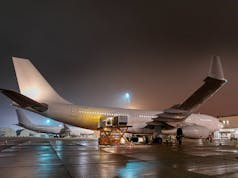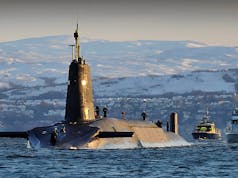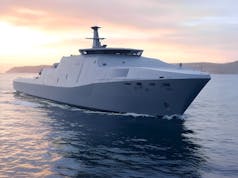Bryan McGrath is a retired naval officer and the Managing Director of The FerryBridge Group LLC. He is also the Assistant Director of Hudson Institute’s Center for American Seapower.
There are many complex questions in modern life that, because of our simplicity, we tend to distill into elementary oppositions. Among these are nature v. nurture, fiscal v. monetary, and Lebron v. Michael.
Thousands of doctoral dissertations and the very existence of sports talk radio attest to the continuing preference for such comparisons, and in general, they provide a reasonable starting point for debate, informed and otherwise.
One such opposition is at the heart of the complex question of how large a Navy the United States needs, and its simplicity provides all manner of rhetorical refuge to those who dabble in Seapower and its relation to the strength of our Republic. The comparison is most often stated as “capacity v. capability,” but dispensing with the jargon, it breaks down to the size of a navy as measured by the number of battle-force ships it fields, versus an understanding of how various attributes of that navy (logistics, networks, precision guided munitions among them) combine to contribute to its overall combat power, numbers of ships playing only one role among many others.
The “capability” side of this argument seems to occupy the rhetorical high ground. Only a Luddite would ignore the impact of technology on naval force structure, a circumstance that provides the opportunity for a smaller, modern, navy to amass greater aggregate combat power than a larger, less capable force of the past. The seemingly self-evident nature of this argument reached its zenith during the 2012 Presidential election when Barack Obama sarcastically dismissed Mitt Romney’s call to increase the size of the U.S. Navy.
The capacity v. capability debate continued to rage during the second Obama term, as Secretary of the Navy Ray Mabus (who wanted more ships) waged a bureaucratic guerrilla war against Defense Secretary Ash Carter—who was aided and abetted by Mabus’ former subordinate Bob Work. Work had risen from Under Secretary of the Navy to the position of Deputy Secretary of Defense and had steadfastly maintained that the shipbuilding budget should be decremented to provide additional resources to capability enhancements elsewhere in the Navy, including increased unit lethality, and electronic and cyber warfare upgrades.
The election of Donald Trump in 2016 seemed to represent the high-water mark of the “capability” crowd, as Trump made a 350-ship Navy the centerpiece of his promise to increase America’s military power, an increase in size of 25% over the force he inherited. Painting in broad strokes due to the nature of political campaigns (and unfamiliarity with the subject), Trump avoided discussions of capability and fixed on a number.
Seven months into the Trump Administration, it appears that the President’s repeated pledge to build a 350-ship Navy is being abandoned in favor of the more nuanced “capability” approach. During his recent confirmation hearing, just-confirmed Secretary of the Navy Richard V. Spencer specifically passed on the opportunity to reinforce the 350-ship goal, choosing instead to resort to the talking points of the “capability-over-capacity” argument, telling the Senate Armed Service Committee, “What I will tell you is that, whether it’s a 355-ship or not, what we also want to get our head around is, can we have a capacity number, but have a capability that’s even greater than that, so have the capability of a 355 that might be a 300-ship Navy.” Shortly thereafter, Chief of Naval Operations ADM John Richardson spoke to the “2017 Naval Future Force Science and Technology Expo” and also created space between himself and a specific number. Notably absent from President Trump’s recent remarks at the commissioning of the nation’s newest aircraft carrier (USS GERALD R. FORD (CVN 78)) was any mention of the 350-ship Navy. A potential reason for this distancing could be the ongoing strategic review underway in the Pentagon, a review that will likely generate bills across the Department of Defense. Given the considerable expense associated with a 25% increase in the size of the Navy, Secretary of Defense Jim Mattis is likely pushing not to be tied down to a specific number.
The lack of nuance and sophistication bound up in a simple numerical representation of naval power is both a blessing and a curse for those who believe “capacity” should be more highly weighted. Because of the Constitutional mandate to “provide and maintain a Navy,” Congress looks to the Executive Branch for input as to how it should do that. The technological sophistication and capital-intensive nature of providing and maintaining a modern Navy requires long term plans against which Congress (and the industrial base) must then allocate resources. Those plans take into consideration a broad national defense strategy, advances in technology, the nature of the threat to American interests, and investments in the fleet already made—as modern warships are designed for service lives of between 25 and 50 years.













The US Navy is immense and is the only player in town wherever it chooses to go.
How they afford it is another matter entirely. I think I am right in saying that their defence budget alone is about the same as the UK’s entire budget for everything. Just staggering, even given the different population sizes. Their budget deficit is obscene and yet they talk about spending more and more on defence. Just silly really, no one can match them as it is!
That sounds about right. Another fact about the US defence budget that puts it into perspective is that if you rank the top 10 countries in the world based on defence spending then the US is at number one, no surprise there, but it is the biggest by such a huge margin that if numbers 2 through 10 on the list all combined their defence budgets together they still wouldn’t be able to knock the US off the number 1 slot. The US is bigger than the next 9 put together.
And G-d bless them for it
During the Obama era, the budget led reductions in ship maintenance, together with high demand for the ships in service, created a back-log in the overhaul schedule . The first stage of increasing the number of ships available to the navy is the investment in the maintenance routine.
The copy/paste from RealClearDefense is quite fuddled.
Trump didn’t pluck the ‘350’ figure out of thin air.
Congress was told by the Navy that at their current workload they would need 360 commissioned vessels.
The last couple of decades have been a farce for the US Navy.
Their next generations of surface combattants (the Zumwalt class & LCS classes) have been an unmitigated disaster.
Because of political choices the US Navy has and will continue to shrink for the coming decade.
Nothing Trump can do can increase the US navy’s size.
If he arrests the decline that will still be an achievement.
In both capacity and capability the USN are getting worse.
The best thing they could do would be to scrap the idea of LCS and Zumwalt replacement and build Arleigh Burke’s for the next 30 years. With updated weapons and systems they would still be too powerful for anything currently in development. It would be a lot cheaper too.
That is already the case Rob.
They restarted building Burkes in 2015 after the Zumwalt went awry.
There will be 11 flight IIA “restart” vessels built for the next decade.
Then comes the new ‘Flight III’ version.
So, they will be building Burkes for 20 years+ after they decided to stop building them several years ago.
The problem is, they are too full.
The hull is struggling to cope with the increased weight and systems demand.
As for whether it will be the best is hard to know.
All the new technology is based on Ballistic missile defence.
They don’t even have room for 2 x CIWS anymore.
I’m unsure how capable a surface fighter it will be given everything is being put into defence rather than offence.
If one had to fight a Chinese Type 55, I’d favour the 55′.
I knew they were restarting with Flight III but I thought they were limiting production in favour of a new surface combatant, allegedly being designed.
Interesting that you would prefer a Type 55, many commentators on here are quite scathing about the Chinese vessels. I do not have enough knowledge to form an opinion on a 55 vs AB battle, but ABs Flight III, IV etc in overwhelming numbers would surely over power any other navy?
Perhaps it is in slow decline, but it’s still enormous by everyone else’s standards, it has the military capacity and qualative edge to take on the combined Navy’s of the world and win, not only that but probably most of the world’s airforces too!
And that’s not even taking into account what the USMC bring to the table…
The question is, how much overkill capability do you really need as the world’s sole super power?
Do defence analysts ever have any formal education in systems? Have any ever read a basic survivability engineering textbook? I recommend the work of Dr. Ball. We used it at the US Naval Postgraduate School.
You could have 1000 ship Navy. And it’d be useless if not kitted out properly. Modern missiles are extremely effective. And they are cheap compared to ships. Subs are still very difficult to detect. And their torpedoes are cheap, and lethal.
Just look at what terrorists were able to do when the Cole was caught off guard? Now imagine an overwhelming attack on several domains. Imagine missiles smart enough that they can sense and plan a flight path to hit at a specific point on the ship. All that means is that in a conflict with a near-peer adversary, it’s capability, not the count that will win the fight. The Chinese for example, could absolutely fire several dozen missiles at a carrier group. You should expect a simultaneous attack by subs, ballistic missiles, ASCMs, aircraft.
There’s no way the Americans could match numbers without significant massing. 300 or 350 ships to cover the globe means a lack of numerical superiority in a theatre. The only way to make up for that is with a qualitative edge so massive that the enemy would risk a substantial loss from just one DDG, let alone a whole carrier group.